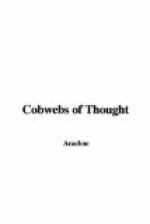It is this gift, which is power, and in George Sand it is a liberating power; it freed her own soul, and it freed the souls of others. She herself felt—and she made readers feel, as in “Lelia,” that outward limitations and hindering circumstances were as nothing compared to the great fact of freedom within, freedom of heart and soul and mind from “the enthralment of the actual.” We are free;—it is a great thing to be as sure and as proud of it as St. Paul was of having been “Free born.” Some of us achieve freedom with sorrow and with bitter tears and with great effort—sometimes with spasmodic effort, and George Sand obtained inward freedom in that way.
But however obtained, the first time a mind feels conscious of it, it is a revelation, and it may come as an influence from an artist soul. George Sand had “l’esprit libre et varie.” George Eliot “l’esprit fort et pesant.” George Sand was widely, wisely, and eminently human. She felt deep down in her heart all the social troubles and problems of her day—and created some herself! But she was true to the artist soul in her—to the belief in an ideal. Art was dormant when she wrote disquisitions, and sometimes her social disquisitions are very long treatises. But her art was not dormant when from her inmost soul she sketched the fate of the Berri peasant whom she loved so well. In the introduction to that simple delightful Idyll “La Mare au Diable,” which should be read by all social reformers and by all who really care for the poor and the causes of poverty, she conveys her conceptions of the mission of art towards the oppressed unhappy labourer; oppressed and unhappy, because with form robust and muscular, with eyes to see, and thoughts that might be cultivated to understand the beauty and harmony of colour and sounds, delicacy of tone and grace of outline, in a word, the mysterious beauty of the world, he, the peasant of Berri, has never under stood the mystery of the beautiful and his child will never understand it; the result of excessive toil, and extreme poverty. Imperfect and condemned to eternal childhood, George Sand recounts his life, touching gently his errors, and with deep sympathy entering into his trials and griefs. And a deeper ignorance, she adds, is one that is born of knowledge which has stifled the sense of beauty. The Berri peasant has no monopoly in ignorance of beauty, and intimate knowledge of toil and extreme poverty, but not many of us feel with the peasant’s fate, as George Sand felt it. She never ceased to care for the cause of social progress, just as she was always heart and soul an artist. George Eliot has written words “to the reader” about the ruined villages on the Rhone. In “The Mill on the Floss,” she writes, and again the remarkable difference between the two writers appears as forcibly as in the two prefaces. “These dead tinted, hollow-eyed skeletons of villages on the Rhone, oppress me with the feeling that human




